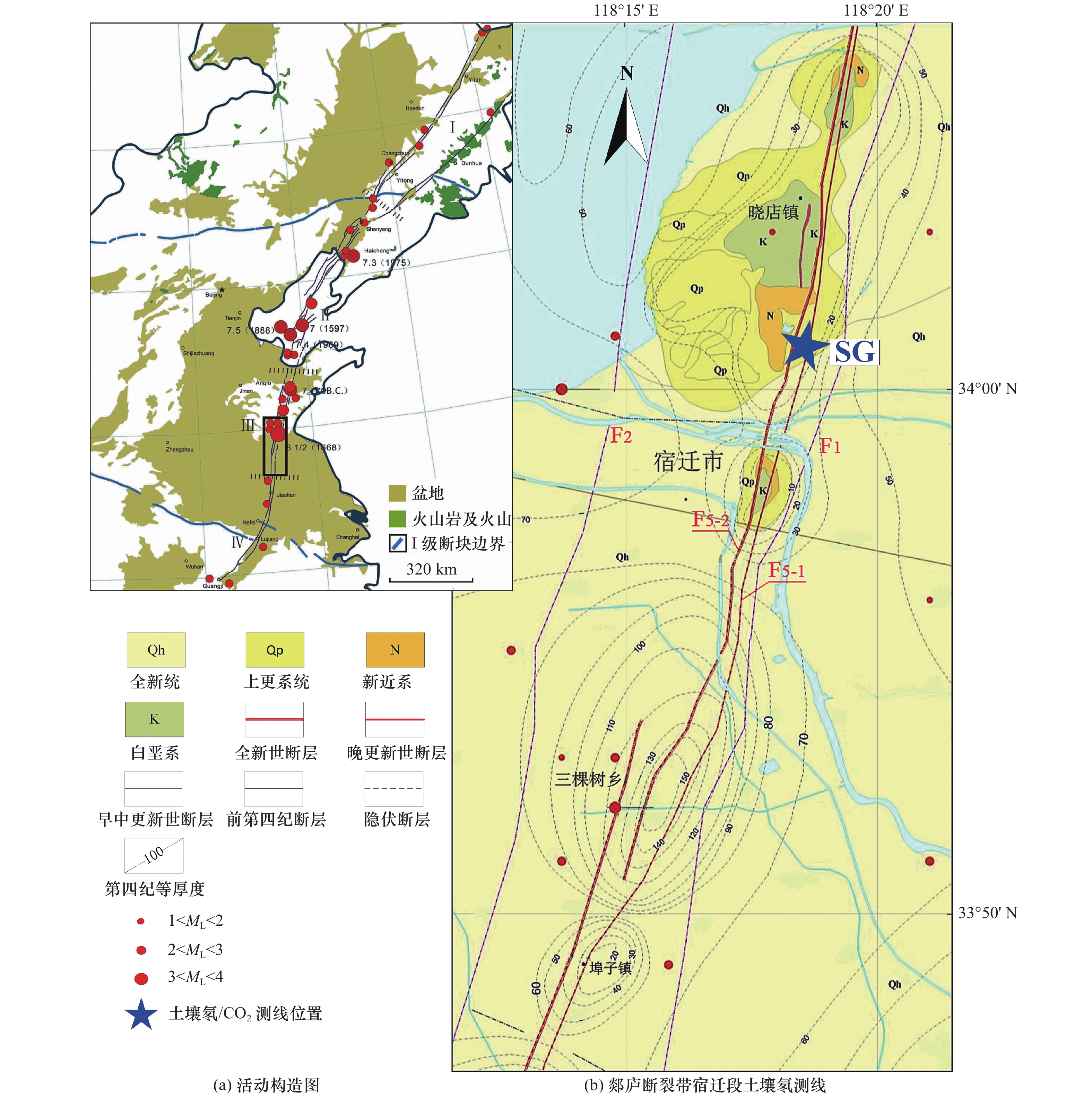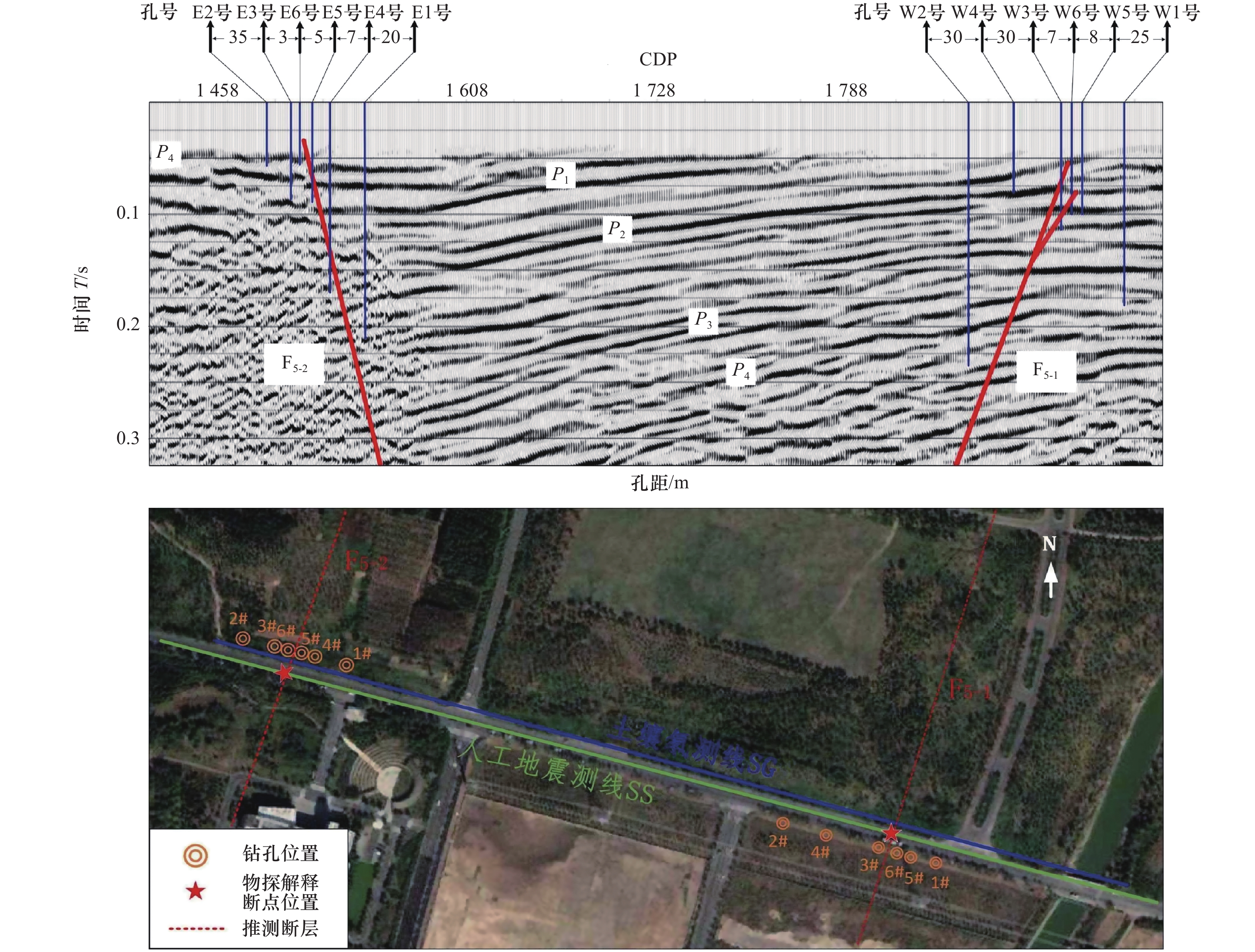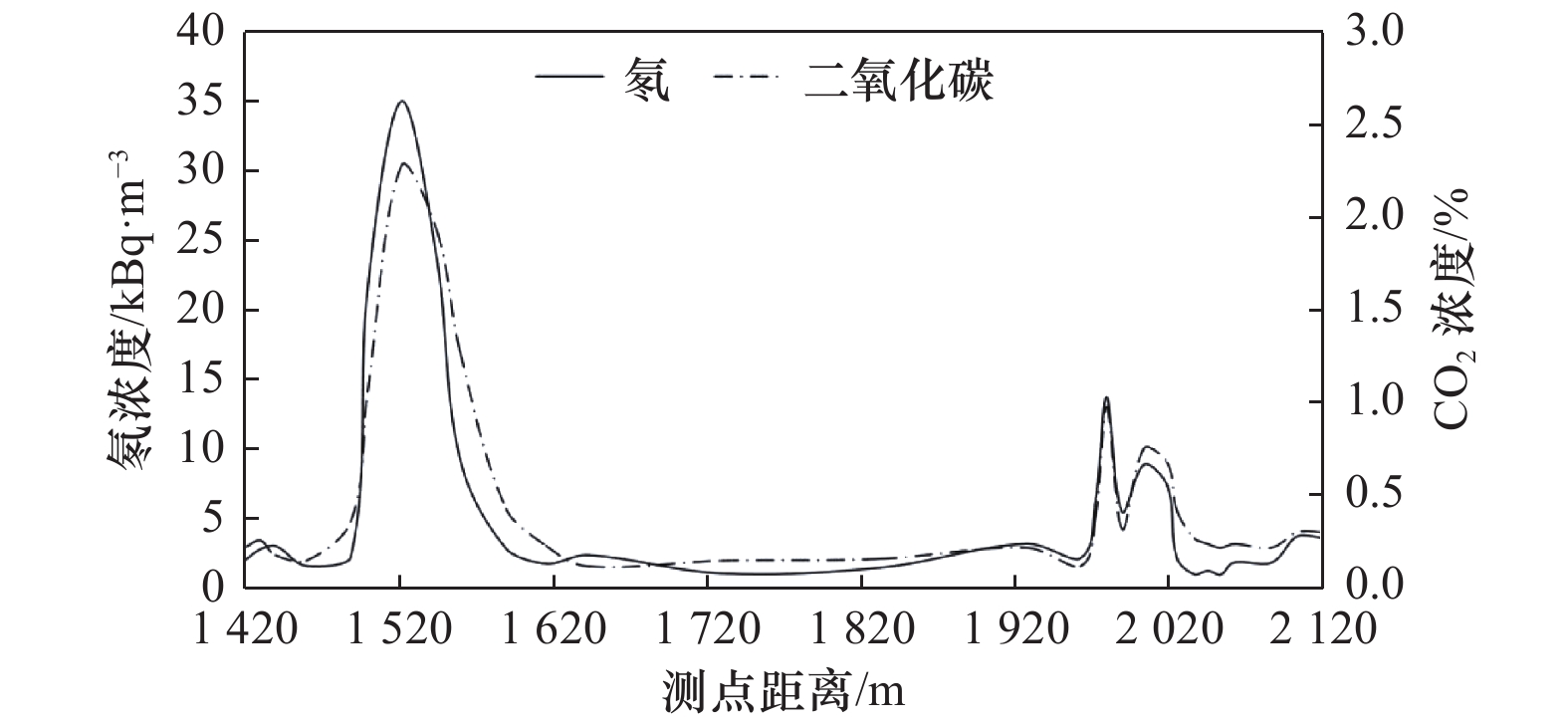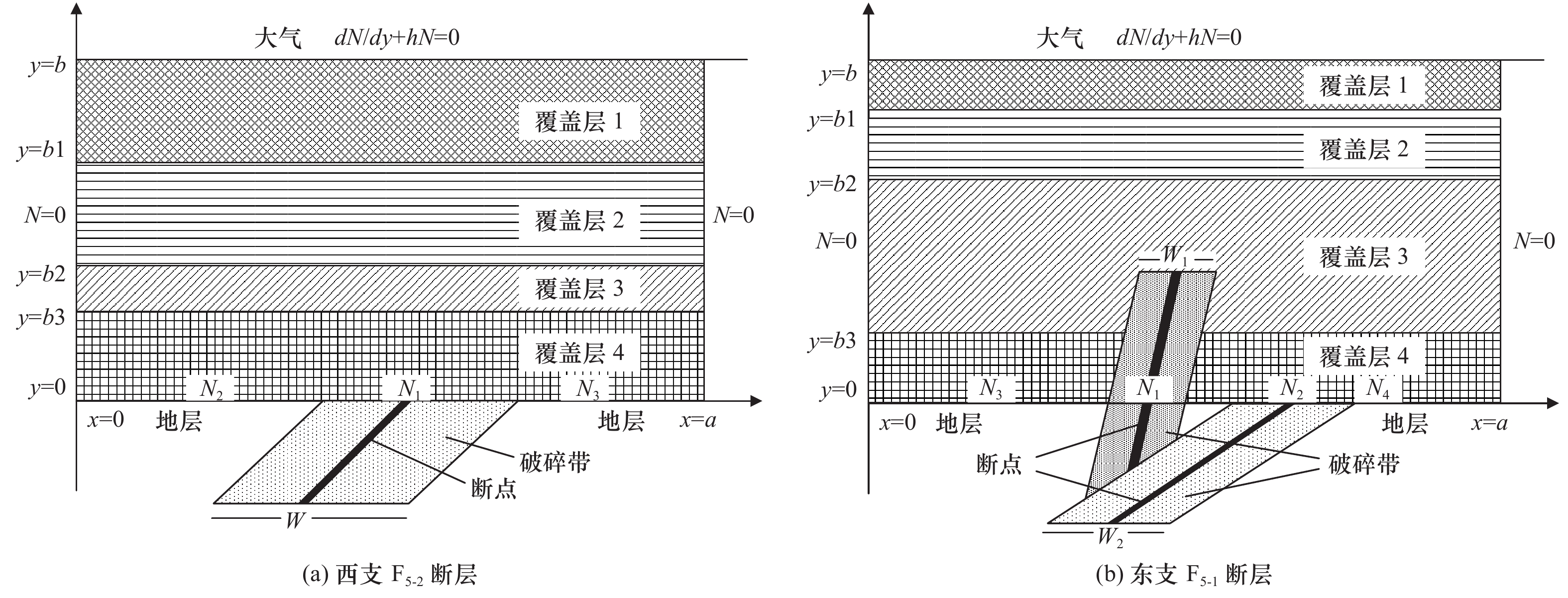Numerical Simulation of Radon Concentration in Soil of Hehuan Road in Tan Lu Fault Suqian Segment
-
摘要: 沿郯庐断裂带宿迁段合欢路布设土壤氡测线并对测得的数据进行分析研究,结果表明研究区域内土壤氡探测结果对断裂带位置、断层类型和特征有较好的指示性。在已知场地地质构造参数、地层岩性特征的基础上,建立土壤氡迁移模型。建立模型时识别了断裂类型和覆盖层分层特征,并讨论了断层内部结构与氡浓度取值,使模型与实际情况相等。数值模拟结果印证了土壤氡异常峰区间在圈定断裂位置和断层破碎带中的重要作用,揭示了氡在不同覆盖层中的迁移速度,并定量解释了合欢路场地断层土壤氡异常的成因。Abstract: Based on the known geological structural parameters and stratigraphic lithology characteristics of the HeHuan road in the Suqian section of the Tan Lu fault, a model of soil radon migration is established. The type of fracture and the layered characteristics of overburden are identified during the model establishment, and we discussed the internal structure of the fault and the radon concentration.This makes the model more consistent with the actual situation.The calculated numerical simulation results are very close to the measured radon curve in soil. The result quantitatively explains the main causes of anomalies in soil radon measurement. It’s confirmed that the abnormal form of soil radon is mainly determined by geological structure, the abnormal values are related to the concentration of cross section and the characteristics of overburden rock formation, the migration velocity of radon in different overburden is different, the range of abnormal soil radon peak can indicate the position of breakpoint and the range of relative fracture.
-
Key words:
- Soil radon /
- Radon migration /
- TanLu fault /
- Active fault /
- Numerical simulation
-
表 1 覆盖层中氡迁移相关参数
Table 1. Parameters related to radon migration in overburden
土壤性质 孔隙度e/% 扩散系数D/10−2 cm2·s−1 有效扩散系数D*/cm2·s−1 对流速度V/10−4 cm·s−1 砂 40.0 4.50~7.00 0.110~0.175 8.0 疏松沉积物 20.0 2.00~2.50 0.100~0.125 6.8 白黏土 59.3 1.53 0.023 4.0 砂质黏土 10.8 1.09 0.100 4.2 表 2 土壤氡测线探测结果与浅层人工地震探测结果
Table 2. Detection results of soil radon line and shallow seismic
土壤氡测线
分段名称测线长度
/m最大值
/kBq·m−3最小值
/kBq·m−3平均值
/kBq·m−3异常下限
/kBq·m−3异常
形态异常峰区
间间距/m异常区间
/m浅层人工
地震测线分支断裂
编号断点位置
/m断错
性质倾向
倾角/°上断点
埋深/mSG1 360 1.09 1.09 9.40 23.46 单峰 - 1490~1545 S F5-2 1508 正断 E70 6 SG2 360 0.99 0.99 4.11 7.77 双峰 23 1970~2022 S F5-1 1988 正断 W65 18 表 3 断点上覆盖层参数
Table 3. Overburden parameters on fault point
断点 断点上覆盖层参数 覆盖层 深度/m 厚度/m 描述 对流速度/cm·s−1 有效扩散系数/cm2·s−1 断裂F5~2断点 1 0~4 4 灰黑、灰黄色黏土,质软 4.5 0.06 2 4~10 6 黄棕、青灰色条纹砂质黏土,含有锰结核和姜结石 6.0 0.11 3 10~24 14 黄棕、青灰色黏土 4.0 0.05 4 24~32 8 黄棕、灰黄色砂质黏土 5.0 0.08 断裂F5-1断点 1 0~2.0 2 灰黑色,黑色黏土,质软 4.5 0.06 2 2.0~3.8 1.8 棕红色,局部有灰色粗砂质黏土,含有钙质结核 6.0 0.11 3 3.8~4.5 0.7 青灰色粉砂质黏土,质软 5.0 0.08 4 4.5~5.8 1.3 棕色、褐棕色黏土,含有铁锰结核 4.0 0.04 -
[1] 晁洪太, 李家灵, 崔昭文等, 1994. 郯庐断裂带中段全新世活断层的特征滑动行为与特征地震. 内陆地震, 8(4): 297—-304.Chao H. T., Li J. L., Cui Z. W., et al., 1994. Characteristic slip behavior of the holocene fault in the central section of the Tanlu fault zone and the characteristic earthquakes. Inland Earthquake, 8(4): 297—304. (in Chinese) [2] 车用太, 刘耀炜, 何钄, 2015. 断层带土壤气中H2观测——探索地震短临预报的新途径. 地震, 35(4): 1—10.Che Y. T., Liu Y. W., He L., 2015. Hydrogen monitoring in fault zone soil gas—a new approach to short/immediate earthquake prediction. Earthquake, 35(4): 1—10. (in Chinese) [3] 戴波, 赵启光, 张敏等, 2020. 土壤氡对郯庐断裂宿迁段F5断裂探测和活动性的研究. 地震工程学报, 42(6): 1479—1486.Dai B., Zhao Q. G., Zhang M., et al., 2020. Detection and activity of the fault F5 in Suqian segment of the Tanlu fault by using soil radon. China Earthquake Engineering Journal, 42(6): 1479—1486. (in Chinese) [4] 杜建国, 宇文欣, 李圣强等, 1998. 八宝山断裂带逸出氡的地球化学特征及其映震效能. 地震, 18(2): 155—162.Du J. G., Yu W. X., Li S. Q., et al., 1998. The geochemical characteristics of escaped radon from the Babaoshan fault zone and its earthquake reflecting effect. Earthquake, 18(2): 155—162. (in Chinese) [5] 付晓飞, 方德庆, 吕延防等, 2005. 从断裂带内部结构出发评价断层垂向封闭性的方法. 地球科学——中国地质大学学报, 30(3): 328—336.Fu X. F., Fang D. Q., Lü Y. F., et al., 2005. Method of evaluating vertical sealing of faults in terms of the internal structure of fault zones. Earth Science—Journal of China University of Geosciences, 30(3): 328—336. (in Chinese) [6] 葛良全, 邹功江, 谷懿等, 2012. 非稳态条件下壤中氡浓度数理模型探讨. 成都理工大学学报(自然科学版), 39(3): 323—327.Ge L. Q., Zou G. J., Gu Y., et al., 2012. Research on mathematic-physical model of radon migration in soil under unsteady conditions. Journal of Chengdu University of Technology (Science & Technology Edition), 39(3): 323—327. (in Chinese) [7] 柯云龙, 刘耀炜, 张磊等, 2018. 川滇地震预报实验场高精度氢观测台阵建设分析. 地震, 38(3): 35—48.Ke Y. L., Liu Y. W., Zhang L., et al., 2018. Establishment and analysis of the high-precision hydrogen observation array in China earthquake science experiment site. Earthquake, 38(3): 35—48. (in Chinese) [8] 刘保金, 酆少英, 姬计法等, 2015. 郯庐断裂带中南段的岩石圈精细结构. 地球物理学报, 58(5): 1610—1621. doi: 10.6038/cjg20150513Liu B. J., Feng S. Y., Ji J. F., et al., 2015. Fine lithosphere structure beneath the middle-southern segment of the Tan-Lu fault zone. Chinese Journal of Geophysics, 58(5): 1610—1621. (in Chinese) doi: 10.6038/cjg20150513 [9] 刘洪涛, 2018. 土壤氡迁移数值模拟及土壤氡对流速度的研究. 北京: 中国地质大学(北京).Liu H. T., 2018. Study on the numerical simulation of soil radon migration and soil radon convective velocity. Beijing: China University of Geosciences (Beijing). (in Chinese) [10] 刘菁华, 2006. 活断层上覆盖层中氡迁移的数值模拟及反演拟合. 长春: 吉林大学.Liu J. H., 2006. Numerical simulation, inversion fitting of radon migration in the overburden above active fault. Changchun: Jilin University. (in Chinese) [11] 刘耀炜, 任宏微, 2009. 汶川8.0级地震氡观测值震后效应特征初步分析. 地震, 29(1): 121—131. doi: 10.3969/j.issn.1000-3274.2009.01.016Liu Y. W., Ren H. W., 2009. Preliminary analysis of the characteristics of post-seismic effect of radon after the Wenchuan 8.0 earthquake. Earthquake, 29(1): 121—131. (in Chinese) doi: 10.3969/j.issn.1000-3274.2009.01.016 [12] 邵永新, 杨绪连, 李一兵, 2007. 海河隐伏活断层探测中土壤气氡和气汞测量及其结果. 地震地质, 29(3): 627—636.Shao Y. X., Yang X. L., Li Y. B., 2007. The result and measurement of soil gas radon and soil gas mercury in the exploration of Haihe hidden fault. Seismology and Geology, 29(3): 627—636. (in Chinese) [13] 汪成民, 李宣瑚, 1991. 我国断层气测量在地震科学研究中的应用现状. 中国地震, 7(2): 19—30.Wang C. M., Li X. H., 1991. Applications of fracture-gas measurement to the earthquake studies in China. Earthquake Research in China, 7(2): 19—30. (in Chinese) [14] 王江, 李营, 陈志, 2017. 口泉断裂断层气地球化学变化特征及断层活动性. 地震, 37(1): 39—51.Wang J., Li Y., Chen Z., 2017. Gas geochemistry and activity of the Kouquan fault in Shanxi province. Earthquake, 37(1): 39—51. (in Chinese) [15] 吴慧山, 1995. 氡测量方法与应用. 北京: 原子能出版社.Wu H. S., 1995. Methods and applications of radon. Beijing: Atomic Energy Press. (in Chinese) [16] 伍剑波, 张慧, 苏鹤军, 2014. 断层气氡在不同类型覆盖层中迁移规律的数值模拟. 地震学报, 36(1): 118—128.Wu J. B., Zhang H., Su H. J., 2014. Numerical simulation for migration rule of fault gas radon in different overburden. Acta Seismologica Sinica, 36(1): 118—128. (in Chinese) [17] 许汉刚, 范小平, 冉勇康等, 2016. 郯庐断裂带宿迁段F5断裂浅层地震勘探新证据. 地震地质, 38(1): 31—43.Xu H. G., Fan X. P., Ran Y. K., et al., 2016. New evidences of the Holocene fault in Suqian segment of the Tanlu fault zone discovered by shallow seismic exploration method. Seismology and Geology, 38(1): 31—43. (in Chinese) [18] 张慧, 苏鹤军, 李晨桦, 2013. 合作市隐伏断层控制性地球化学探测场地试验. 地震工程学报, 35(3): 618—624.Zhang H., Su H. J., Li C. H., 2013. Field test on the geochemical detection of concealed fault in Hezuo city. China Earthquake Engineering Journal, 35(3): 618—624. (in Chinese) [19] 周慧玲, 苏鹤军, 张慧等, 2018. 基于孕震物理模式的断层气流动监测网络布设技术. 地震工程学报, 40(5): 1052—1060.Zhou H. L., Su H. J., Zhang H., et al., 2018. Mobile monitoring network layout technique for fault gas based on seismogenic mode. China Earthquake Engineering Journal, 40(5): 1052—1060. (in Chinese) [20] 周晓成, 王传远, 柴炽章等, 2011. 海原断裂带东南段土壤气体地球化学特征. 地震地质, 33(1): 123—132.Zhou X. C., Wang C. Y., Chai Z. Z., et al., 2011. The geochemical characteristics of soil gas in the southeastern part of Haiyuan fault. Seismology and Geology, 33(1): 123—132. (in Chinese) [21] Abdoh A., Pilkington M., 1989. Radon emanation studies of the Ile Bizard Fault, Montreal. Geoexploration, 25(4): 341—354. doi: 10.1016/0016-7142(89)90005-7 [22] Baubron J. C., Rigo A., Toutain J. P., 2002. Soil gas profiles as a tool to characterise active tectonic areas: the Jaut Pass example (Pyrenees, France). Earth and Planetary Science Letters, 196(1—2): 69—81. [23] Giammanco S., Gurrieri S., Valenza M., 1998. Anomalous soil CO2 degassing in relation to faults and eruptive fissures on Mount Etna (Sicily, Italy). Bulletin of Volcanology, 60(4): 252—259. doi: 10.1007/s004450050231 [24] Ho C. K., 2008. Analytical risk-based model of gaseous and liquid-phase radon transport in landfills with radium sources. Environmental Modelling & Software, 23(9): 1163—1170. [25] Iakovleva V. S., Ryzhakova N. K., 2003. Spatial and temporal variations of radon concentration in soil air. Radiation Measurements, 36(1—6): 385—388. [26] Janik M., Bossew P., 2016. Analysis of simultaneous time series of indoor, outdoor and soil air radon concentrations, meteorological and seismic data. Nukleonika, 61(3): 295—302. doi: 10.1515/nuka-2016-0049 [27] King C. Y., King B. S., Evans W. C., et al., 1996. Spatial radon anomalies on active faults in California. Applied Geochemistry, 11(4): 497—510. doi: 10.1016/0883-2927(96)00003-0 [28] Lombardi S., Voltattorni N., 2010. Rn, He and CO2 soil gas geochemistry for the study of active and inactive faults. Applied Geochemistry, 25(8): 1206—1220. doi: 10.1016/j.apgeochem.2010.05.006 [29] Toutain J. P., Baubron J. C., 1999. Gas geochemistry and seismotectonics: a review. Tectonophysics, 304(1—2): 1—27. [30] Wakita H., Nakamura Y., Notsu K., et al., 1980. Radon anomaly: a possible precursor of the 1978 Izu-Oshima-Kinkai earthquake. Science, 207(4433): 882—883. doi: 10.1126/science.207.4433.882 [31] Walia V., Yang T. F., Lin S. J., et al., 2013. Temporal variation of soil gas compositions for earthquake surveillance in Taiwan. Radiation Measurements, 50: 154—159. doi: 10.1016/j.radmeas.2012.11.007 [32] Yakovleva V. S., Parovik R. I., 2010. Solution of diffusion–advection equation of radon transport in many-layered geological media. Nukleonika, 55(4): 601—606. [33] Zhang W., Zhang D. S., Wang X. F., et al., 2014. Analysis of mathematical model for migration law of radon in underground multilayer strata. Mathematical Problems in Engineering, 2014: 250852. -




 下载:
下载:







